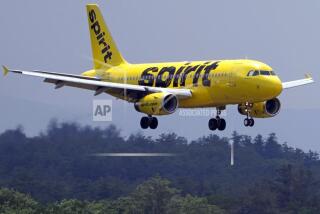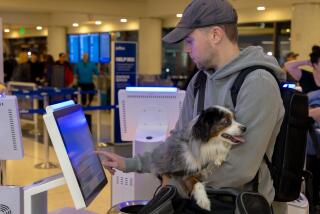Airlines Have Yet to Lift Off
- Share via
The airlines are gradually luring more travelers to the skies thanks to a spate of fare sales, but the carriers remain in deep financial trouble as they brace for the seasonally slow winter months, statistics released Friday show.
Even so, airline stocks rose again as investors appeared to speculate that the industry eventually will rebound this year, making current stock prices attractive.
Several major U.S. and foreign carriers, including American Airlines and British Airways, said their December passenger-traffic figures showed a slight improvement from November trends, but they were still down substantially from December 2000.
That’s not surprising because most airlines massively scaled back their operations and work forces because of the post-Sept. 11 plunge in travel. But what concerns the airlines and analysts is that average fares, or yields, being generated by passengers today remain weak.
That means most of the airlines, even with their cuts in service and labor costs, are still unable to turn a profit. The U.S. airline industry alone is expected to report a loss of $6 billion to $10 billion for 2001, and to keep racking up losses in the first half of this year.
What the airlines could use, most observers agree, is a rebound in business passengers who typically pay higher fares. But business travel, which was tapering off before Sept. 11, is still down sharply from a year ago because of the weak U.S. economy. And corporations are balking at paying higher fares for employees’ travel until their own businesses show improvement.
The airlines “need to get their yields up, which means they either raise the price or lower the cost” of service, said Ron Kuhlmann, vice president at Roberts, Roach & Associates, an aviation consulting firm in Hayward, Calif. However, “they’re limited in the price increases they can charge. People are only willing to pay so much.”
Another sign of the airlines’ struggle came Thursday from Travelocity.com, the online travel-services concern, which said its fourth-quarter results would be worse than expected because of “unexpectedly slow sales of airline tickets during the December holiday travel period” and “related air-fare reductions.”
The airlines’ trade group said U.S. carriers boarded 12% fewer passengers over the holiday period than they did a year ago. The airlines recorded 20.2 million revenue passenger miles from Dec. 20 to Jan. 2, compared with 23 million a year ago, the Air Transport Assn. said Friday. A revenue-passenger mile is one fare-paying passenger carried one mile and is the industry’s unit of traffic measurement.
For now, the airlines are taking some solace from filling their planes with vacation travelers taking advantage of cheaper fares. “A lot of the traffic is being won back by deeply discounting,” said Raymond Neidl, an analyst at the investment firm ABN Amro in New York. “The business travelers probably won’t come back until you see some positive signs in the economy.” Indeed, new fare sales were announced Friday by Southwest Airlines, Northwest Airlines and America West Airlines.
American, a unit of AMR Corp., said its December passenger traffic fell 17% from a year earlier. And even after taking into account the cutbacks in its service, the airline said its load factor--the percentage of its seats filled with passengers--fell 1.7 points from a year ago, to 67.2% in December. American, the nation’s largest airline, said its traffic for all of 2001 fell 10% from the prior year.
US Airways reported a 22% drop in December traffic, while Continental Airlines had an 11% decline and Alaska Airlines a 5% decline. Among foreign carriers, British Airways and KLM Royal Dutch Airlines both posted a 10% drop last month. However, those declines represented an improvement from the year-over-year declines they suffered in November. “There’s a recovery in sight,” said Howard Wheeldon, an analyst at Prudential Bache Ltd. in London. “But it’s not a full recovery and it will take time.”
The exception again was Southwest, the short-haul carrier that thrives on cheap fares because it has some of the lowest operating expenses in the industry. The Dallas-based airline, which did not cut flights or jobs after Sept. 11, said its December traffic edged up 0.6% from a year ago--the first year-over-year monthly increase in passenger traffic for a major U.S. airline since the terrorist attacks. Southwest’s stock gained 20 cents, to $19.11 a share, Friday on the New York Stock Exchange, while AMR rose $1.41, or 6%, to $25.05. The American Stock Exchange’s index of airline stocks overall gained 3.48 points, or 3.7%, to close at 98.54 points.
Investors “appear to be looking longer term, expecting both an industry and economic recovery in the spring,” Neidl said in a bulletin to clients Friday. “We do not disagree with this assessment.” However, Travelocity’s revised forecast sent its stock tumbling $3.05, or 11%, to $24.39 a share on Nasdaq.
UAL Corp.’s United Airlines and the other major carriers are expected to post their December traffic figures over the next few days.
*
Bloomberg News and Associated Press were used in compiling this report.
More to Read
Sign up for The Wild
We’ll help you find the best places to hike, bike and run, as well as the perfect silent spots for meditation and yoga.
You may occasionally receive promotional content from the Los Angeles Times.







